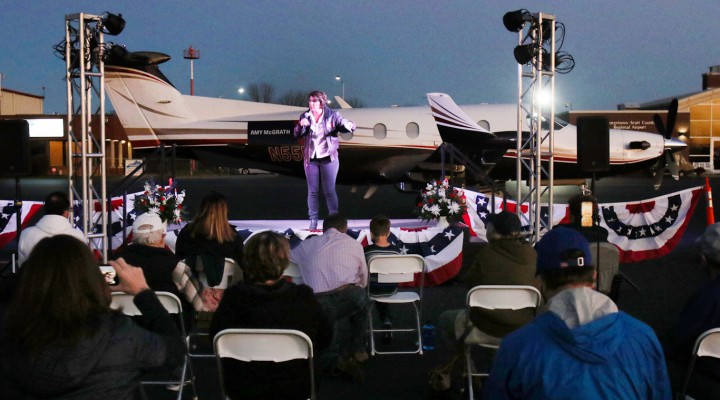Nine of the 10 Most Expensive Senate Races in US History Happened in 2020

Elections are getting far more expensive. The 2016 election alone cost around $6.5 billion, and there is only one place to get money like that: super-wealthy donors with deep pockets and high expectations.
MPN– It had already been established that the 2020 election was by far the most costly of all time, with political parties spending $14 billion — more than twice as much as in 2016. But a new report from the Center for Responsive Politics has found that nine of the costliest Senate races of all time occurred in 2020.
The most expensive race was in North Carolina, which pitted Republican incumbent Thom Tills against Democratic challenger Cal Cunningham. There, the two parties sank nearly $300 million into the contest, which ended with almost exactly the same polling figures as it had four years before, resulting in a Republican victory.
In neighboring South Carolina, Democrats sank over $130 million into a quixotic attempt to unseat prominent Senator Lindsey Graham, who himself spent more than $100 million. As in North Carolina, the result was markedly similar to 2014, with Graham winning 54% of the votes (he won 55% six years earlier).
Democratic donors also funneled more than $90 million to right-wing candidate Amy McGrath in the fanciful dream of unseating Senate Majority Leader Mitch McConnell of Kentucky. McGrath often pitched herself as a “pro-Trump” Democrat in the vain hopes of picking off hundreds of thousands of supposedly “moderate” Trump voters. McConnell won by 20 points, carrying 117 of the state’s 120 counties, and greatly increasing his vote total from 2014.
The other most expensive Senate elections of 2020 included Iowa ($261.6 million), Arizona ($248.5 million), Maine ($204.5 million), Michigan ($191.2 million), and Montana ($190.1 million). Florida’s 2018 Senate election was the only previous contest to make the top ten.
Money was the deciding factor in most races; 70% of the contests were won by the biggest spender. That figure rises to 88% of all elections to the House of Representatives. The 70% figure is actually a decrease on previous years, as many of the Democrats’ big money moves, like those in South Carolina and Kentucky, came to naught. In the 24 states where Democrats significantly outspent their opponents, they carried only 13, losing nine. By comparison, the GOP won all eight states where they spent more. Overall, Democrats spent $280 million more than Republicans, but failed to flip the Senate, gaining only one seat more than in 2018.
Elections are getting far more expensive. The 2000 contest between George W. Bush and Al Gore is reported to have cost around $3 billion, with 2016’s election estimated at $6.5 billion. The only place to get that sort of money is from the super-wealthy. Ultraconservative multi-billionaire Sheldon Adelson (number 36 on Forbes’ worldwide rich list) was the largest individual donor, channeling over $183 million to Republican sources. For the Democrats, Michael Bloomberg and Tom Steyer were the top donors, spending $111 billion and $68 billion, respectively. Unlike Adelson, Bloomberg and Steyer also attempted to take direct control of their party, both (unsuccessfully) running to be its leader in 2020.
Cash rules everything around me
In 1995, political scientist Thomas Ferguson developed his investment theory of politics, stating that elections are essentially contests between rival big businesses and that the two political parties compete to serve those who pay them, not the public. Nearly 20 years later, a University of Princeton study of 1,779 policy issues found that,
Economic elites and organized groups representing business interests have substantial independent impacts on US government policy, while average citizens and mass-based interest groups have little or no independent influence.”
In other words, on virtually every issue, the government carries out the will of the rich and ignores that of the poor majority.
Even if Americans are unaware of the academic research, they agree that big money has a highly negative impact on U.S. politics. 75% of young Democrats and 63% of young Republicans believe the presence of big money is among the most responsible factors for the state of America today. And nearly eight in ten Americans told the Pew Research Center in 2018 that they wanted to see laws enacted that would limit the amount of money that rich individuals or well-funded PACs could spend on political campaigns.
In recent years, a number of anti-establishment candidates have run on an explicit rejection of corporate money, preferring instead to crowdfund from small donors. But considering the enormous and increasing cost of running for office, it is not clear whether this technique will pay off without comprehensive campaign finance reform. As the Center for Responsive Politics wrote, “small donors make good press, big donors get you reelected.”
Nine of the 10 Most Expensive Senate Races in US History Happened in 2020
Feature photo | Senate candidate Amy McGrath speaks to supporters at the Georgetown-Scott County Regional Airport, Georgetown, Ky, Nov. 3, 2020. James Crisp | AP
 TheAltWorld
TheAltWorld 
0 thoughts on “Nine of the 10 Most Expensive Senate Races in US History Happened in 2020”